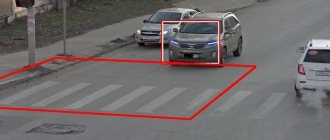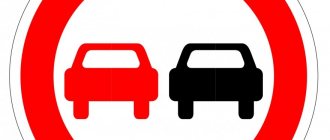Home / Autolight
Back
Published: 03/01/2021
Reading time: 8 min
0
825
- Definition of the term
- Why are side lights needed?
- Where are they located?
- Types of side lights
- How to use it correctly
Side lights are part of the car's lighting system and are present in all models without exception. This option is used in certain conditions to reduce the risk of accidents and to indicate a vehicle that is parked on the side of the road and in other places with insufficient lighting.
American type parking (marker) lights
In the United States, most parking lights have been used in conjunction with turn signals (turn signals) for a long time. As a rule, cars for the American market use double-helix lamps inside the turn signals, one of which lights up constantly when the lights are on, and the other lights up when the turn signals are turned on. In this case, the side lamps begin to blink in a brighter color.
The side lights turned on on cars from the USA look especially interesting in the photographs.
What are the types of side lights and their design?
Replacing the side light bulb: 2 detailed instructions and 5 useful tips
According to traffic rules, side lights, which every car owner must turn on, must be located in front and behind. The headlights can be blue, yellow or white - it doesn't matter. Also, blue or other marker lights are installed on the sides of the vehicle. It should be noted that both front and rear marker lights on cars and trucks can be part of an entire headlamp assembly or mounted separately.
Today, the traffic rules state that they must be exclusively white, but in fact, a fine is not issued for using, for example, blue or yellow lights. Fines are issued to owners of trucks and cars; if the driver forgets to turn them on, this is a more serious problem.
By the way, only in the USA the front marker lights may not be blue or white, but amber. As for the rear optics of trucks and cars, according to traffic rules, headlights must only be red. The use of other colors is impractical and, in principle, can be dangerous for road users (video author - AutoFlit).
It should be noted that the light source in this flashlight is a halogen bulb. Also, recently, LEDs, or entire LED blocks, have been used in such optics. If you install blue or other non-standard light sources in the headlights on the roof or on the sides of the car, then you need to take into account that the lamps on the taillights should not burn as brightly as the brake lights. It is necessary to turn on the headlights on the front, rear or roof of cars or trucks when it gets dark; they also turn on automatically when the low beam headlights are activated. Some modern passenger cars are equipped with the function of turning on the lights on only one side, this allows you to determine the dimensions of the car in the parking lot in the dark.
White marker lamps as part of a separate lamp
This type of parking lights is more familiar in our country as many older cars are equipped with this type of parking lights. The thing is that this type of parking lights was often used until recently in European, Asian and Russian cars.
This type of size is a separate lamp installed in a transparent lamp (lantern). According to GOST, side lights must be installed on both sides of the vehicle in pairs on the same line.
Reasons for replacing the side light bulbs
Replacing lamps in restyled and pre-restyled cars is different. As a rule, in the first case, replacement is somewhat more difficult. Nowadays, replacements do not need to be made so often because LEDs have replaced the old incandescent lamps. However, there are situations in which replacement is definitely worthwhile:
- You want to improve the appearance of your car and get brighter bulbs. It is worth remembering that LEDs combine well with cold xenon.
- You want to increase the life of your side lights. LEDs have a longer lifespan than incandescent bulbs.
- You want to reduce the amount of electricity you consume or simply keep up with current technological trends.
The reasons for the lamp malfunction may lie in a manufacturing defect. Cheap Chinese lamps quite often fail before the stated end of their service life. Also, the malfunction may be hidden in the car’s electrical network or a leak in the headlight.
Side parking lights
There is another type of side lights that were installed on old cars of the 80s and early 90s (mainly Japanese cars). We are talking about white side parking lights that turned on on the side of the intended turn or lane change when parking.
By the way, unlike the flashing turn signals, the white side lights were constantly on when parking.
Do-it-yourself faults and troubleshooting
The traffic rules clearly state everything that concerns this type of optics. As you remember, operating a vehicle at night with the optics turned off or not working is prohibited and punishable by a fine. So, if you notice that even one light bulb in your car is flickering or broken, we recommend replacing it and installing a new one as soon as possible. Otherwise, you may be punished by a traffic police officer, because this is actually considered using a car in a defective condition.
Bulbs for dimensions
As practice shows, when you decide to replace halogen elements with more modernized LED ones, an error may appear on the instrument panel. The size sensor failure indicator will signal to the car owner that the front or rear optics are not working correctly. This situation occurs as a result of the fact that the power level of LED elements is significantly lower than that of traditional incandescent light bulbs. Accordingly, in some cases, the electronic control unit may simply not recognize such power after replacement.
If you think that this problem needs to be solved, then you need to do the following. Directly in front of the diode itself, special resistors are installed that will reduce and stabilize the voltage level. Not all cars allow the installation of LED optics, so in some cases it is advisable to use traditional light bulbs. Moreover, in such cases, savings on voltage consumption will be minimal.
Car rear marker
It often happens that a car owner forgets to turn off the lights after turning off the engine and leaves the car in this state. Subsequently, this will lead not only to increased battery discharge, but also to accelerated failure of the light bulb itself, which will require its replacement. Today, many modern cars are equipped with a reminder function for just such situations - when the driver opens the door, the on-board computer will give him an appropriate sound signal. This way the person will be able to remember that he did not turn off the lights.
Also, many vehicles have a function that automatically turns off the lights when the ignition key is removed from the lock. In addition, if the motorist forgot to turn off the lamps, the car can turn them off on its own when the central locking is turned on. This feature is often found on Nissan vehicles. As practice shows, light bulbs that are installed in dimensions are usually characterized by a long service life. If a car enthusiast needs to replace elements, then, as a rule, this does not require much time and effort.
If you notice that the light bulbs are not working correctly or are blinking, you must:
- check the functionality of the elements;
- check fuses;
- ring the wiring.
Old style parking lights
Some older domestic vehicles used another type of parking lights. For example, starting in 1968, Moskvich-408 cars received side parking lights installed on the rear body pillars. These lights were turned on by a special toggle switch in the car's interior. Later, Moskvich abandoned this type of parking lights.
Today, such parking lights are usually installed on buses, trucks and other special equipment.
What are these headlights and their purpose?
Side lights are a type of lighting equipment that every motor vehicle is equipped with.
They are also called parking (parking) lights, sidelights and simply dimensions. This is a separate optical device or an integral part of the main headlight.
Parking lights are installed in the front and rear of the car, as well as on the sides. The placement is on the same line, two lights in front, two in the back.
Dimensions are needed to visually indicate the size of the vehicle.
While driving and when stopping transport, they attract attention and warn other drivers. Thanks to the side lights, the car is clearly visible at night.
Compared to other headlights, the lamps have low power and produce dim light. This is designed to save battery life when parked. On a sunny day, the included dimensions are simply not noticeable.
Sometimes drivers believe that during the day they can only drive with side lights. This is not true: turning on daytime running lights or low beam headlights is required and is required by traffic regulations.
These devices are not replaced by side lights. The traffic police inspector will consider the fact an administrative offense with corresponding consequences.
Novice drivers often make the mistake of not making a distinction between side lights and other lighting devices: daytime running lights and fog lights.
Side lights according to their functional purpose and placement are:
They are intended to indicate the overall width of the vehicle on the corresponding side.
Front
Front side lights are also called parking lamps or sidelights. Their location is along the edges of the front of the car, on the same line.
On cargo transport they are carried onto the wings. They are also located in this place on older passenger cars.
The front lights are only white. They are turned on at night and when visibility is insufficient in combination with other optics: fog lights, high and low beams.
Rear
Tail lights are installed at the rear of the car. Their location is along the same line on the sides. On buses and trucks, rear markers are additionally installed in the upper part.
They are an integral element of headlights and have exclusively red light.
Typically, the rear lights are turned on at the same time as the front lights. The principle of switching on is the same: either it is a separate button on the control panel, or the lights turn on automatically when you turn the key in the ignition.
Lateral
These side lights indicate the boundaries of the vehicle when viewed from the side. Used for mechanical vehicles and trailers. Should emit a yellow color, in some cases red.
If a vehicle with a trailer is more than 6 m long, it is necessary to install front and rear side markers: 2 on each side. This requirement is established by GOST R 41.91-99 (UNECE Rules No. 91), a European level standard.
Side lights inside the main headlight
Another type of installation of parking lights. True, it is also less common. For example, similar parking lights were found in Volkswagen Beetles, Nissan Pao and Porsche 356. With this design, the parking lamps are installed inside the main headlights.
But such use of dimensions is ineffective, since the marker lamp inside the headlight produces a very dim glow.
What color should headlights be according to traffic regulations?
Do-it-yourself replacement of Lada Granta running light bulbs
So, above we have already indicated that there are only 3 options:
- White color,
- yellow,
- orange.
This is prescribed by paragraph 3.6 of the Basic Provisions of the Traffic Regulations, which indicates malfunctions and conditions under which it is prohibited to drive a car:
Please note that this quote refers to all external lights at the front of the vehicle, not just the headlights. This also includes fog lights, turn signals and additional lighting fixtures
All of these primary colors can technically have shades. For example, xenon that is too cold can emit blue or purple. How strongly these shades will influence the possibility of a fine, alas, will be decided by the traffic police officer on the road according to his inner conviction and then by his boss and/or the court if you appeal the decision.
You can also, for example, replace the lamps in the headlights with a cooler or, conversely, warmer color. However, the light source itself should not change. If, for example, you had halogen lamps, then you cannot install LED or xenon lamps, and vice versa.
Contradiction with GOST
- low beam headlights must be white only,
- for distance, only white is also allowed,
- for fog lights - white or yellow,
- turn signal (front and side) – yellow,
- front marker - white,
- DRL (daytime running lights) – white.
As you can see, there is no talk of any orange at all, and only white color is provided for headlights - also no yellow.
Table of permitted colors of lighting devices
| Front light fixture | According to traffic rules | According to GOST |
| Low beam headlight | White, yellow, orange | White |
| High beam headlight | White, yellow, orange | White |
| DRL | White, yellow, orange | White |
| parking lights | White, yellow, orange | White |
| Turn signal | White, yellow, orange | Yellow |
| Fog lights | White, yellow, orange | White or yellow |
But here everything is actually simpler. The driver must first of all follow the traffic rules. In addition, when imposing a fine, the norm of Part 1 of Article 12.5 of the Code of Administrative Offenses of the Russian Federation is indicated, which prescribes punishment specifically for violation of the Basic Provisions of the Rules, and not GOST.
But the traffic rules still refer to this State Standard, however, only in one requirement for the driver - a ban on operating the car if the headlight adjustment does not comply with the above GOST (clause 3.2 of the Basic Provisions).
Thus, despite the fact that GOST prescribes only white headlights, there is no fine for violating the standard. There are penalties for traffic violations, and in them you can use white, yellow or orange on the front.
So, what are side lights for?
As you probably already guessed, parking lamps are designed for... parking. That is, you should use your side lights when you park your car.
Don't believe me? Then you seem to have forgotten paragraph 19.3 of the Rules of the Road:
- 19.3 Traffic rules of the Russian Federation: When stopping and parking at night on unlit sections of roads, as well as in conditions of insufficient visibility, the side lights on the vehicle must be turned on . In conditions of poor visibility, low-beam headlights, fog lights and rear fog lights can be turned on in addition to the side lights.
Also, don't forget that parking/marker/parking lights came out in an era when the world's street lighting still left much to be desired. In those days, in the evening, the streets of even large cities were very dark. As a result, in those years, motorists, as a rule, parked their cars in dark, narrow streets.
In order for a car standing on the road to be visible to all drivers passing by, front and rear marker lights were invented. By the way, parking lights, as a rule, are not bright, but dim. This is done intentionally so that the parking lights do not drain the car's battery while parked. So the dimensions consume little energy due to their low power.
No, of course, side lights can easily drain a new battery to zero. But to do this, you must leave your car in the parking lot for a day (more or less depending on the make, model of the car and battery capacity).
See also: Inattentive drivers face new fines - Parking for electric vehicles in Moscow
By the way, there is even a persistent myth that car enthusiasts have been telling each other for a long time about the fact that side lights greatly drain the battery. That is why a large number of car owners, having parked their car on the road for a while, do not turn on the lights for fear of draining the battery.
Moreover, often people, saving energy in the battery, do not turn on the side lights even where it is dangerous. For example, parking a car on the side of the road on a dark highway. But this not only violates the current Traffic Rules, but also increases the risk of getting into an accident. After all, drivers of other cars may not notice you. So why violate it when the dimensions when parking the car temporarily will not drain the battery? Agree, there is no point. Therefore, always turn on your headlights at night when you park your car. Remember that they are not useless.
Fortunately, in many modern cars, the side lights (if they are not present, the daytime running lights are turned on) turn on automatically when the key is turned in the ignition.
But nevertheless, some even new cars still have a separate button for turning on the side lights. In this case, do not forget to include them where necessary. Especially when driving out on the road at night.
External car lights
At the beginning of this article, a few words about what external lighting devices a car may have.
This information is primarily intended for those who are studying at a driving school and do not yet understand what these or other headlights or lanterns are intended for. Note. The topic “lighting devices” is one of the most difficult in a driving school, because... It is difficult for a driver candidate who has never driven before to remember the similar names of light devices and the rules for their use.
parking lights
Dimensions are small light devices located approximately at the corners of the car (4 pieces in total). They do not shine very brightly and are primarily designed so that drivers of other cars can understand in the dark where your car begins and ends.
As a rule, the car is designed in such a way that when you turn on the low or high beam headlights, the dimensions turn on automatically. That is, low beam without side lights does not work.
DRLs are light devices in the front of the car (2 pieces), which shine quite brightly. They are designed to improve visibility of the car from the front during daylight hours.
Daytime running lights should not be used at night because... at night, they can blind oncoming drivers due to their high brightness. However, they do not illuminate the road.
In 2021, most cars are equipped with daytime running lights, but such lights are quite rare on cars manufactured before 2010.
Low beam (2 bulbs) and high beam (2 bulbs) headlights are the main lighting devices that are designed to illuminate the road in front of the car.
In this case, the low beam illuminates the area directly in front of the car, and the high beam illuminates a more distant area. It makes sense to use low beam at low speeds, high beam at higher speeds.
PTF – 2 headlights in the front bumper of a car, designed to illuminate the road in poor visibility conditions.
Fog lights are optional for 2021, so not all vehicle trim levels have them. That is, the car may not have PTF.
Fog light - a red light at the rear of the car, designed to improve the visibility of the car in poor visibility conditions. This light device is very bright and in good weather it can blind drivers of cars behind.
This lamp is required to be installed on all cars.
At night, or the dark time of the day, the rules refer to the period of time between the end of the evening and the beginning of the morning twilight. In such conditions, it is mandatory to turn on the headlights and side lights.
The choice of low or high beam depends on the following nuances:
- If you are driving along illuminated roads in a populated area, you cannot use high beams, only low beams.
- When approaching a vehicle moving in the oncoming lane, the high beams should be switched to low beams at least 150 meters in advance - this way you will not blind the other driver. It’s even better to switch at 200-250 meters.
- If an oncoming vehicle signals by switching or flashing its headlights at a greater distance, turn off the high beams. In such situations, your headlights are most likely poorly adjusted, and they do not so much illuminate the road as they shine into the eyes of oncoming drivers.
- You also need to switch the lights in other situations when there is a threat of blinding other drivers, both oncoming and passing.
What to do if you are blinded? The main thing is not to change lanes, otherwise there is a risk of getting into an accident, hitting a pedestrian or falling into a ditch. The rules require in such a situation to turn on the hazard warning lights, gradually reduce speed and, if necessary, stop.
Forced stop in the dark - be sure to turn on the side lights and, if desired, supplement them with low beams and fog lights.
Tail lights
Tail lights used on cars in Russia can only be red. The use of markers of a different color is prohibited.
Typically, tail lights are installed as part of a single tail light unit. According to current legislation and traffic regulations of the Russian Federation, trucks and buses must also be equipped with additional side lights indicating the size of the vehicle.
As a rule, in all cars the rear marker lights turn on together with the front lights. To do this, either use a separate button located in the cabin, or the lights are turned on automatically after turning the key in the ignition (automatic turn on of the lights is used in many modern cars).
Where are they located?
The arrangement of dimensions is usually standard, but there are features in cars of certain brands. The standard arrangement is in the headlights and taillights, but there are several features that are shown in the photo.
The standard option, which is a low-power bulb located in the front headlight together with the low or high beam.
In modern cars, dimensions are most often implemented in the form of LED lighting. It not only consumes little electricity, but also performs a decorative function, making a particular brand recognizable.
The tail lights are always red. They can be either in the form of a light bulb under a red diffuser, or in the form of an LED module.
For trucks, light sources are located not only from below, but also from above, as well as from the side. To enhance the effect, reflective elements are also glued to the surface.
And buses should also be equipped with additional lights so that drivers can assess the size of the vehicle from afar.
Is there liability for side lights that are not turned on?
Yes and no. The thing is that there is no separate liability for side lights that are not turned on in Russian legislation. There is only general article 12.20 of the Code of Administrative Offenses of the Russian Federation, which prescribes the responsibility of drivers for violating the rules for using external lighting devices , sound signals, hazard warning lights or warning triangles. Let us repeat that, according to Article 12.20 of the Code of Administrative Offenses of the Russian Federation, the driver faces a fine of 500 rubles.
Accordingly, if the driver does not turn on the side lights when stopping and parking the car in the dark on an unlit road, then he may be brought to administrative liability by traffic police officers. For example, if you stopped on the side of the road at night and did not turn on your side lights, you may be subject to administrative liability.
Vehicle lighting devices - rear lights
In fact, the main functional responsibility of the rear lights is to inform everyone driving behind us about what we plan to do while driving - stop, turn, back up, and so on.
For this, there is a set of special light sources, which, as a rule, are combined into one housing.
In the literature, such a unit is called differently - rear combination lights, rear light module or rear light unit. Typically this unit includes the following lighting devices:
- parking lights;
- brake lights;
- reverse signal;
- turn signals;
- reflectors (retroreflectors).
The rear fog lamp and license plate lights are installed separately from the unit.
Of course, the set we have listed, located in one case, is not at all an unshakable rule, because manufacturers really like to experiment with the design and shape of flashlights.
Because of this, the above-mentioned vehicle lighting devices may not be in a single unit, but they should be located in the rear of the car in any case, since this is regulated at the legislative level in many countries of the world.
Let's go through each of the lighting devices we have listed to figure out how much they are really needed.
parking lights
In common parlance - dimensions. They serve, as you might guess, to designate a vehicle on the road so that other drivers can see our car in advance, standing, for example, at the side of the road.
In the rear of the car, they are located on both sides of the body, should have a red glow and, as a rule, are structurally combined with brake lights.
Brake lights
In turn, brake lights also have a red glow, but much more intense. They turn on automatically when you press the brake pedal.
By the way, in many countries a mandatory condition is the presence of an additional brake light, which must be installed in the middle of the body and above the line of the main lights.
Reverse signal
Our next hero is the reverse signal. This is a white light, indicating that the car has engaged reverse gear and is starting to move backwards.
Turn signals
The functions of turn signals, we think, are already clear to everyone. The only thing I would like to note is that they should be yellow, located on both sides of the body and signal the maneuver by flashing at a frequency of 60 to 120 times per minute.
Now, on almost all cars, double turn signals (yellow) are installed on the side of the front fender
Reflectors (reflectors)
Reflectors are an important element in the dark. Especially if the vehicle is parked and all lights are, of course, turned off. When light hits them, reflectors are effective over a long distance and let other drivers know in advance that there is a car ahead and they need to be careful.
Optional rear fog lights are also a desirable feature. It has an intense red glow, necessary to identify itself in foggy or poor visibility conditions. In order to prevent confusion with the brake light, manufacturers mount the fog lamp separately from the headlight unit, although this is not a uniform rule.
Vehicle lighting devices must include illumination of rear license plates. It should be white and properly cover the area of the entire license plate. This element of lighting equipment turns on automatically along with the side lights.
In what other cases do you need to turn on the side lights?
Drivers must turn on their side lights not only when stopping or parking their car at night. Also, side lights should be turned on when visibility is insufficient. For example, during the day and at night during snowfall, rain, fog, etc. Including in cloudy weather. Naturally, in conditions of insufficient visibility, in addition to the side lights, you should turn on low beam headlights, front and rear fog lights (if necessary).
Device
Illumination of the front and rear dimensions is included in the design of the optics. So, the front light will be equipped with a lamp that will have a white light, and the rear light will have a red light.
Side lights are always yellow. Most cars have a white light bulb installed in the socket, but its glow depends on the color of the backlight element housing. However, there are car models in which each headlight is white, but the bulbs glow in accordance with the type of signal provided by the manufacturer:
- Turning and side lighting - yellow glow;
- Rear optics - red light, with the exception of turn signals in some models, as well as a reversing light;
- The front optics are white except for the turn signals.
What are the responsibilities for installing blue (or other color) marker lamps?
In accordance with the current legislation, established provisions of GOST, as well as in accordance with the requirements for the approval of vehicles for operation, for the use of red marker lamps in the front part (instead of white), as well as other colors (green, red, etc.), liability is provided for Part 3 of Article 12.5 of the Code of Administrative Offenses of the Russian Federation. Here is the text of the law:
- Part 3 of Article 12.5 of the Code of Administrative Offenses of the Russian Federation “Driving a vehicle on the front of which are installed lighting devices with red lights or red reflective devices, as well as lighting devices, the color of the lights and the operating mode of which do not comply with the requirements of the Basic Provisions for the Admission of Vehicles to Operation and responsibilities of officials to ensure road safety
- entails deprivation of the right to drive vehicles for a period of 6 months to 1 year with confiscation of the specified devices and accessories.”
In the rear, the side lights should be red. Accordingly, the use of lamps of a different color is also prohibited.
See also: On October 14, 2021, traffic police changes to the rules for issuing driver’s licenses will come into force
So, as you can see, despite the advent of daytime running lights, which have begun to replace classic side lamps in the front end, the era of parking lights is not over yet. At least in the rear of all cars, classic marker lamps installed in the taillights are still used.
The thing is that side lights are very necessary. After all, they help motorists see other cars on the road.
Side lights and daytime running lights: what's the difference?
If the indicators must be left active when stopped, then daytime running lights are needed to indicate the car while driving, even during the day. Neither the first nor the second category of illumination is an alternative to low beam at night.
If in the evening or during bad weather a road safety officer stops a vehicle traveling only on clearance, the driver will be issued a fine. You can drive either with DRLs or with the headlights on in low beam mode. The dimensions are used for parking purposes, and not to save battery resources when the car is driving.
The design of all cars is equipped with side or parking lights by default. As for running lights, in some models they are not used at all, but they can be placed near the headlights and connected through a separate button or together with the car’s lighting.
What is important to know
Some car enthusiasts believe that a malfunction of the side lights is not fraught with anything. In fact, the risk of an accident increases, since other drivers may simply not notice, for example, a parked car without a light signal. In addition, the driver of a car with faulty lamps may receive a fine. Here's what's worth knowing:
- Leaving the side lights on for a long time causes the battery to discharge . In many cars, the driver has some kind of reminder: if the lights are on and the car door is opened, an audible signal sounds. In most modern vehicles, the lights turn off automatically;
- The car is equipped with malfunction indicators for both side lights and brake lights. The indicator can notify the driver of a malfunction if the halogen light source is replaced with an LED one. To solve the problem, it is enough to install an additional resistance in front of the diode - the on-board computer analyzes the health of the system based on power consumption and voltage stability, which will return to normal;
- Replacing halogen lights with LED lights is not always advisable;
- The driver may be fined for using the wrong color lights.
Among the advantages of LEDs over the usual incandescent lamps, sellers usually highlight lower energy consumption (the savings are insignificant, but still nice) and greater brightness. But something else is really interesting: the operating time. LED lights work for about 100 thousand hours . They also have tremendous resistance to vibrations, temperature changes and mechanical overloads. The main disadvantage of LEDs is the price.
Smart search and purchase
You don't have to rely on your VIN to find new parking lights. You can search both by transport data and by the type of bases used. This information is called to the manager of the automotive lighting store or entered into the online catalog search engine.
When choosing a standard incandescent lamp, you should give preference to the original, since in terms of workmanship it is superior to any branded lamps. We'll talk about analogues later. But as for LED lamps, the situation here is more interesting. LEDs, even of average quality, last a very long time in practice. The main complaint about them is brightness. If you want to save money wisely and get a decent LED lamp, pay attention to the SF series . If your budget allows, take lamps with built-in stabilizers. The fact is that the generator, when operating, induces high currents and voltages in the circuit, due to which the LEDs quickly degrade. A more expensive LED lamp with a stabilizer always lasts much longer than a budget lamp.
Please note: the use of LED lights is conditionally acceptable, but you may not be able to pass MOT. Typically, drivers simply remove all LEDs from the exterior lighting, leaving only the interior LED bulbs.
When do you need to turn the side lights on and off according to the rules?
First of all, it is worth remembering paragraph 19.3 of the norms of traffic and behavior on the road. Following this point, when making a stop or stopping for parking at night or on a roadway with insufficient lighting, in conditions of poor visibility, the vehicle must be illuminated by its dimensions.
In certain situations, in low light or poor visibility, the car must be additionally illuminated with low beams or fog lamps.
Also, this type of headlights is required to be turned on at night, at dusk, on a road with poor visibility, for a car in tow or on a trailer.
According to established requirements, the driver must include the following dimensions:
- During a short stop on the highway. At the same time, the alarm signal is turned on;
- When parking near shops, centers, in poor visibility conditions;
- If you are driving along a highway in foggy conditions;
- In rainy conditions.
The lights are turned off during daylight hours or when the vehicle is left in its parking space. Despite the low consumption, turning on the light overnight can easily drain even a new battery.
How to make turn signals larger?
If you want the turn signals to light up in your vehicle, then this is quite possible and even quite simple. But we must not forget that operating the vehicle in this form is prohibited.
So, to make the turn signals larger, you need to do the following:
- First, remove the turn signal lamp; this procedure is individual for each car. To do this, remove the headlight.
- Remove the ground wire of the elements; it must be connected to the power supply of the dimensions.










